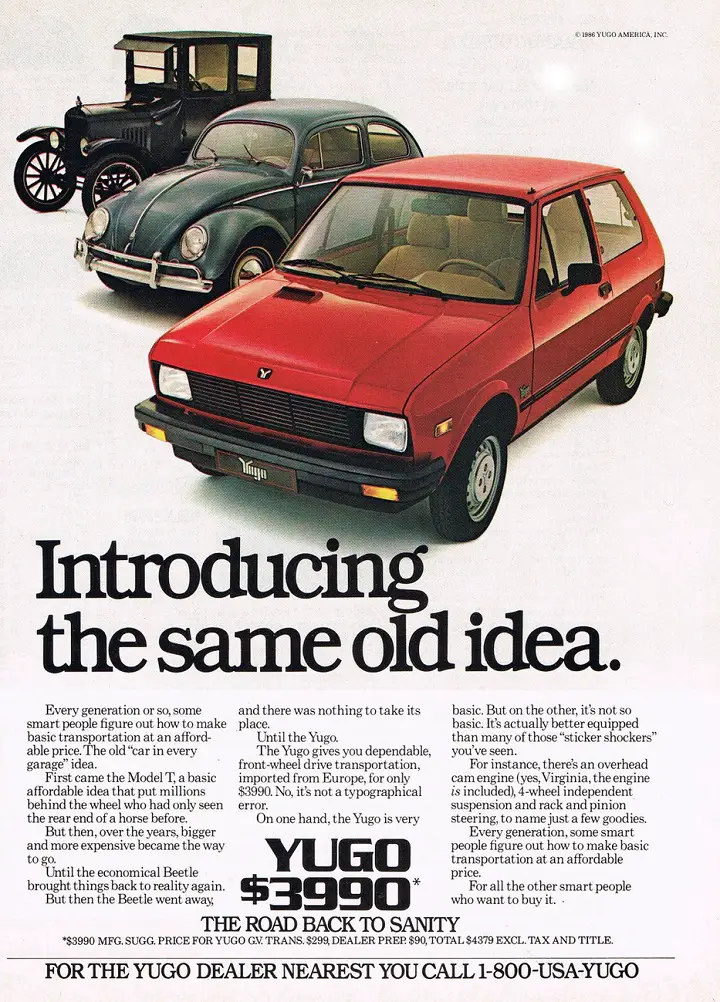Even people who weren't born before 1985 know that the Yugo is a synonym for automotive crapulence – one of the most laughable, undependable, unfortunate products ever hawked in the United States.

Jason Vuic's fascinating book, The Yugo: The Rise and Fall of the Worst Car in History, provides a detailed roadmap of how this sad hunk of car came to be. It's a thoroughly weird saga that involves a shady entrepreneur, backwards factories in Serbia, and comedians who loved to hate on this untrendy auto.
Why do Yugos have a heater for the back window?
To keep your hands warm as you push it.
Now, the Yugo is a distant memory in the United States. It's nearly impossible to find one for sale online, unless you want to buy one that's been repurposed as a Whalemobile. "Here, the Yugo is out of sight, out of mind," Vuic tells us. "It didn't even make it in the VH1 series 'I Love the '80s.'"
Do you have disposable cash and a dream that involves a terribly inept car? Then read on to find out how to fail, Yugo-style.
First, find yourself a charming capitalist cowboy

Malcolm Bricklin is the man guilty of bringing the Yugo to America. (Coincidentally, he's also the father of Jonathan Bricklin, the co-owner of the ping-pong club SPiN and the possible lover of Susan Sarandon.) Bricklin burned through several other ventures -- and plenty of other people's cash -- before launching his Yugo importation business.
A man walks in to a parts store and asks, "Can I get a new gas cap for my Yugo?"
The attendant replies, "sounds like a fair trade to me."
In the 1960s, he decided to import the Subaru 360, a Japanese car so light that it was considered a "covered motorcycle," and therefore immune from U.S. automotive regulations. In 1969, Consumer Reports magazine rated the scrawny vehicle "not acceptable" and sales plummeted.
In the mid-1970s, Bricklin attempted to market a car oh-so-humbly named the Bricklin, whose gullwing doors are perhaps an unconscious inspiration for the more recent Mercedes-Benz SLS AMG. Only 2,854 models were produced before the company went bankrupt.
Not undeterred, Bricklin continued to import cars, and eventually sought to again import a simple, low cost car to the U.S. market. This time looking to Yugoslavia, he, along with Henry Kissinger (as advisor) and Lawrence Eagleburger (former U.S. Under-Secretary of State, as board member) met with Zastava Automobiles in Serbia and hammered out a deal. Bricklin would import their four-door hatchback supermini Zastava Koral and market it as the Yugo.
Why don't Yugos sustain much damage in front-end collisions?
The tow truck takes the impact.
"I never really saw him as a con man," Vuic says. "He wants all his ideas to work. It's the chase that excites him, that motivates him, not necessarily the money."
Make sure the price is right (and buy earplugs)

Perhaps well aware of the power of 9s, Bricklin set the price for the most basic Yugo at $3,990, considerably cheaper than competing models at the 1985 launch.
He was likely hoping that this insane price made up for the car's other shortcomings, such as the unholy racket it made. Vuic notes that a Car and Driver report found the volume of a 70-mph Yugo nearly as loud as the Lamborghini Countach 5000, a vehicle with considerably more muscle.
Open your factory in a Communist backwater
Yugos were produced at the Crvena Zastava factory in Kragujevac, Serbia. The plant's pre-automotive expertise was in making weaponry.
What do you call a Yugo at the top of a big hill?
A miracle!
As Vuic makes clear, attention to detail and fine engineering were not exactly the high points of the Yugoslavian Communist mentality. And what's more, Zastava employees were generally under the influence of sljivovica, a "delicious" plum brandy that made the work day seem to go that much faster.
Add a laugh track
The Yugo was massively popular before it was a massive joke; many Americans found themselves "proud" owners of this plucky, economic deathtrap.
Then came the official reviews of the Yugo, which were less than outstanding. "We think you'd get better value from a good used car than a new Yugo," wrote a Consumer Reports reviewer.
"That phrase -- that it was better to buy a good used car than a new Yugo -- was picked up by journalists and run again and again in the press," says Vuic. "David Letterman asked, 'What's the number one mafia euphemism for death? Bought a Yugo.' By 1986, it was a common belief in America that the Yugo was junk, even though few Americans had ever seen or driven the car."
Make it kill you
Unlike contraptions like a Smart car -- which looks like it'll kill you, but probably won't -- the Yugo was a highway mortality waiting to happen.
The problem with driving a Yugo...is that the Czech engine light is always on.
The vehicle, Vuic notes, had "the eighth highest death rate of the 134 most popular 1984–88 model cars on U.S. roads between 1985 and 1989, with 3.6 occupant deaths per 10,000 cars."
And the worst part? That means you'd be dying in a Yugo.
 |
 It's All Fucked Shirt $22.14 |
 |
Urkel drove a Yugo. Need I say more?